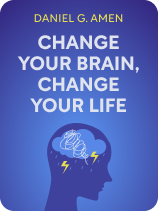

This article is an excerpt from the Shortform book guide to "Change Your Brain, Change Your Life" by Daniel G. Amen. Shortform has the world's best summaries and analyses of books you should be reading.
Like this article? Sign up for a free trial here.
What does the anterior cingulate gyrus do? What does it have to do with decision-making and conflict resolution?
Most people have never heard of the anterior cingulate gyrus, but they use it all the time. This part of your brain helps you think more effectively. Dr. Daniel G. Amen explains its role in his book Change Your Brain, Change Your Life.
Keep reading to learn what the anterior cingulate gyrus does in your everyday life.
What the Anterior Cingulate Gyrus Does
What does the anterior cingulate gyrus do? According to Dr. Amen, the anterior cingulate gyrus plays a crucial role in mental flexibility and decision-making. For example, it allows you to easily shift your attention from one task to another or adapt smoothly to a new idea. Your anterior cingulate gyrus accomplishes this by doing the following:
- Facilitating cognitive flexibility: It promotes the ability to effortlessly shift attention between various topics, ideas, and issues—fostering a versatile and fluid thought process.
- Enhancing error detection and conflict resolution: It serves as a cognitive center for detecting errors and resolving conflicts during decision-making, contributing to improved cognitive functioning.
| Neural Dynamics Within the Anterior Cingulate Cortex The anterior cingulate cortex (another term for the anterior cingulate gyrus) comprises intricate neural layers. Unraveling these neural complexities will provide insight into the mechanisms that enable cognitive flexibility, error detection, and conflict resolution. Pyramidal neurons in layer V of the anterior cingulate cortex contribute to communication with the dorsolateral prefrontal cortex. These neurons adjust neural activity, supporting processes that shift your attention between tasks for flexible and fluid thinking. Neurons in the dorsal anterior cingulate cortex (dACC) establish connections with the prefrontal cortex and subcortical structures, forming a specialized neural circuit. This circuit finely tunes neural connections to swiftly identify errors, resolve conflicts, and optimize cognitive functioning and decision-making. |

———End of Preview———
Like what you just read? Read the rest of the world's best book summary and analysis of Daniel G. Amen's "Change Your Brain, Change Your Life" at Shortform.
Here's what you'll find in our full Change Your Brain, Change Your Life summary:
- A more effective approach to overcoming physical, mental, and cognitive issues
- The four factors to nurture to improve your brain health
- Why listening to Mozart can enhance your focus and mood control






